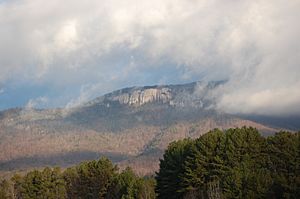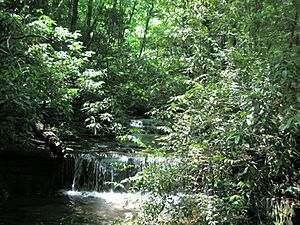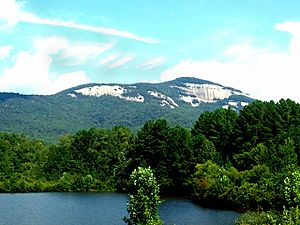Table Rock State Park (South Carolina) facts for kids
Quick facts for kids Table Rock State Park |
|
|---|---|

Table Rock Mountain
|
|
| Nearest city | Pickens, South Carolina |
| Area | 3,083 acres (12.5 km2) |
| Created | 1935 |
| Camp sites | Both regular and RV campsites Mountain cabins are also available in the park |
| Hiking trails |
|
| Other information | Leashed pets are allowed everywhere except for cabin areas. |
| Website | Table Rock State Park |
Table Rock State Park is a huge park, about 3,083-acre (12.48 km2) in size. It sits right at the edge of the Blue Ridge Mountains in northern Pickens County, South Carolina. This amazing park is home to Pinnacle Mountain, which is the tallest mountain completely inside South Carolina!
Contents
What Can You Do at Table Rock State Park?
Table Rock State Park has lots of cool things to see and do! There's a special lodge that was built a long time ago by a group called the Civilian Conservation Corps (CCC). This lodge has a kitchen and a big dining room that can seat 72 people.
The park also has two lakes where you can go swimming during certain times of the year. If you love to hike, there are trails that lead to beautiful waterfalls like Mill Creek Falls. You can also hike to the very top of Pinnacle Mountain (there are two ways to get there!) and to the summit of Table Rock Mountain.
There's a nature center where you can learn about the plants and animals in the park. Plus, you'll find picnic areas and a playground, perfect for a fun day out with family and friends.
Explore the Trails at Table Rock
Table Rock State Park is famous for its awesome hiking trails. Each one offers a different adventure!
Carrick Creek Nature Trail
The Carrick Creek Nature Trail is about 1.9-mile (3.1 km) long and loops around two creeks. You'll see small waterfalls and cascades, and if you visit in the right season, the trail is full of colorful wildflowers. It's a great path for a relaxed walk and to enjoy nature.
Table Rock Summit Trail
If you're looking for a challenge, the Table Rock Summit Trail is for you! It's about 3.5-mile (5.6 km) long and goes up about 2,000 feet (610 m) from where you start. Along the way, you'll find a shelter that was also built by the CCC.
About 2.5 miles (4.0 km) into the hike, the trail splits. If you go left, you'll follow a ridge trail that leads to Pinnacle Mountain. If you go right, you'll head to the summit of Table Rock, which is 3,124 feet (952 m) high! From the top, you'll get an amazing view of Table Rock Reservoir and Caesars Head.
Foothills Trail
Table Rock State Park is also the starting point for the eastern end of the Foothills Trail. This super long trail is about 80-mile (130 km) and goes through the beautiful Blue Ridge Escarpment.
The History of Table Rock State Park
The land where Table Rock State Park now sits has a very old and interesting history.
Native American History
Before a special agreement called the Hopewell Treaty was signed in 1785, this area was part of the Lower Cherokee Nation. The Cherokee people called this place "Sah-ka-na-ga," which means "the Great Blue Hills of God." They had many hunting camps here.
According to old stories, Table Rock Mountain got its name from a Cherokee legend. The legend says that the flat top of the mountain was like a giant table where the Great Spirit would eat his meals.
Early Settlers and Hotels
After the Hopewell Treaty was signed, European settlers started moving into the Oolenoy River Valley. They built a town called Pumpkintown, which was named because of the really big pumpkins that grew there!
In the past, people like William Sutherland and James Keith ran a place for visitors to stay. In 1845, they built a big hotel called the Table Rock Hotel, which had twenty rooms. It was very popular until the Civil War. After the war, visitors started coming back, and Stephen Keith reopened the hotel. Later, in 1899, his family built a new hotel on a different spot on the mountain, but they stopped using it by 1912.
Table Rock State Park Historic District
|
Table Rock State Park Historic District
|
|
| Lua error in Module:Location_map at line 420: attempt to index field 'wikibase' (a nil value). | |
| Nearest city | Pickens, South Carolina |
|---|---|
| Area | 2,860 acres (1,160 ha) |
| Architect | J.W. Linley |
| Architectural style | Late 19th And Early 20th Century American Movements, CCC construction |
| MPS | South Carolina State Parks MPS |
| NRHP reference No. | 89000478 |
| Added to NRHP | June 15, 1989 |
In 1935, about 2,860 acres (11.6 km2) of land was given to the state of South Carolina by Pickens County and the city of Greenville. This is how Table Rock State Park began!
How the CCC Helped Build the Park
The park was built in the 1930s by a special group called the Civilian Conservation Corps (CCC). At first, two groups of World War I veterans worked on the park. However, they were a bit older for the tough work needed to build a dam and work in the mountains.
So, in 1936, younger CCC groups took over. One group (Company 5466) built a concrete dam and spillway to create the 23-acre Pinnacle Lake. The other group (Company 5465) built many miles of trails, roads, a bathhouse (for changing clothes after swimming), a building for snacks, fish-rearing pools, eight cabins, picnic shelters, and houses for the park's superintendent and warden.
One of the most important buildings they made was a lodge built from logs. It had a big main hall and a dining hall, sun porch, and kitchen downstairs. The CCC also planted natural plants from the Pinnacle Lake area to make the park look beautiful. Table Rock State Park officially opened to the public with a ceremony on April 4, 1938.
Recognizing the Park's Importance
The Table Rock State Park Historic District was added to the National Register of Historic Places in 1989. This means it's recognized as a very important historical place. Other related sites, like the Civilian Conservation Corps Quarry No. 1 and Truck Trail, Civilian Conservation Corps Quarry No. 2, Roper House Complex, and Table Rock Civilian Conservation Corps Camp Site, were also listed in 1989. The park is also a South Carolina Heritage Trust Site, which helps protect its history and nature.



